#broad winged damselfly
Text
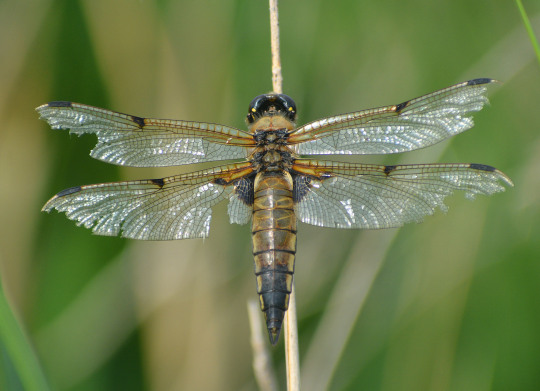


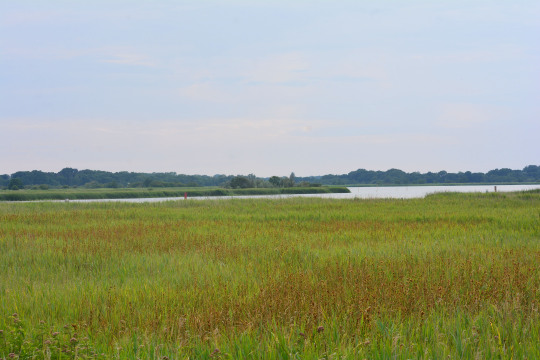
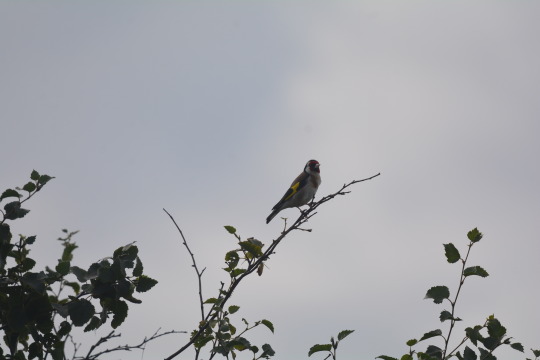
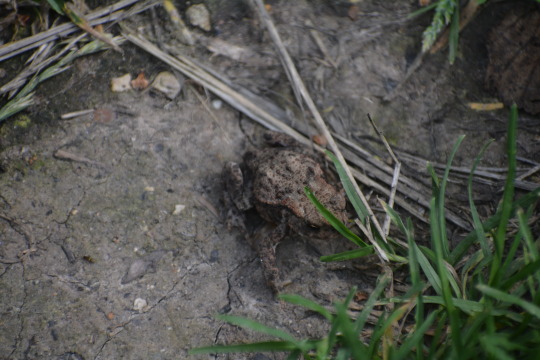




08/07/2023-Swallowtail and more at Hickling Broad
Photos in this set are of: 1. The dragonfly that caught my eye and us stopping to look at put us in the right place at the right time to see the Swallowtail, a dazzling insect to watch itself with its worn but still impressive wings glistening in the emerging sunlight, a Four-spotted Chaser. 2, 4, 8, 9 and 10. Views at this beautiful broads spot, I really enjoyed coming here last year and did again. A truly lovely place. 3. A key flower of the site which I very much enjoyed seeing, hemp agrimony. 5. Goldfinch. 6. A nice little toad we liked coming across. 7. A Black Clock beetle one of a few new insects I enjoyed discovering on the walk round this reserve.
Of course when it comes to other highlights this is dominated by one of my greatest ever wildlife watching moments, as that sensational Swallowtail emerged and heavily glided through the air; flashing its racy bright colours and grand, intricate and emblematic markings like a sightly cathedral on wings. This was such a big and long awaited moment for me, I can already see it's one of those moments I just want to replay in my mind over and over. It was an insect fest with my first Brown Hawkers seen from the off at the car park, rustic Ruddy Darter and Emerald Damselflies of the year alongside many Black-tailed Skimmers a smashing day for dragon and damselflies. Red Admiral, Peacock, Meadow Brown and Gatekeeper were other good butterflies to see. Fine caterpillars, Peacock butterfly and Garden Tiger moth moments after the Four-spotted Chaser and dream Swallowtail sighting furthered the delve into new species and little things of nature on the walk. It was a great one for birds too with typical Norfolk bird Marsh Harrier, Great White Egret, Little Egret, Grey Heron, Lapwing, Egyptian Goose, Pheasant, Reed Bunting and fittingly Swallow other key birds seen. Other flowers enjoyed on the walk were my first melilot of the year, bird vetch, yarrow, bindweed, nightshade, red campion, herb-Robert, pineappleweed, buttercup and honeysuckle. As we did when we visited last year on the way out we saw a Kestrel closely on a wire nearby. What a phenomenal day.
#swallowtail#hickling broad#norfolk broads#norfolk#england#uk#world#nature#butterfly#butterflies#marsh harrier#great white egret#swallow#ruddy darter#brown hawker#hemp agrimony#emerald damselfly#happy#lapwing#egyptian goose#birdwatching#insects#dragonflies#flowers#europe#2023
7 notes
·
View notes
Text

Damselfly sp.

A dragonfly nymph

A tad pole with legs of Japanese wrinkled frog which are getting rare and can be found only here in this region according to the member of our Environmental NPO group.

A mature broad-winged damselfly
0 notes
Photo
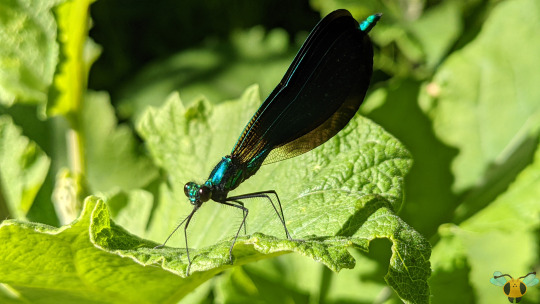



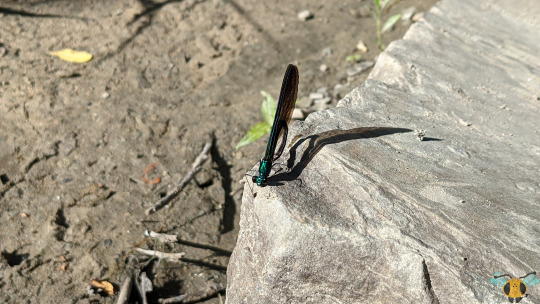


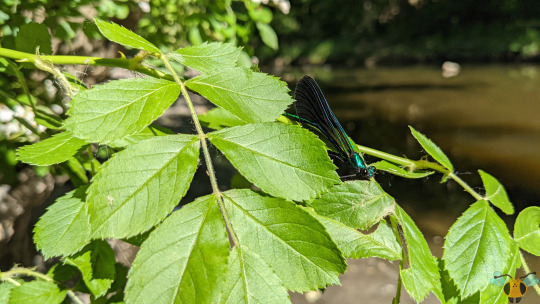
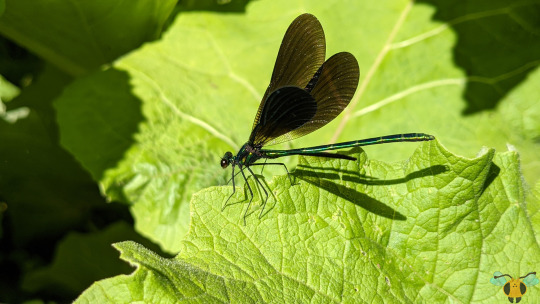

Ebony Jewelwing - Calopteryx maculata
Goodness me, I’m thrilled to showcase this bejeweled, metallic green, magnificent insect after its been absent from this blog for such a long time. Honestly, I was beginning to wonder if I would ever find one again around the neighborhood. Fortunately, they were in season and there were a good handful to be found by the water, basking in the sunlight (in a sort of obelisk position). Depending on the angle and lighting (along with individual variation), their color might be more blue than green, but they are still elegant to observe. Compared to all other Damselfly species on this blog (at time of writing), this specie belongs to the Broad-Wing Damselfly family (Calopterygidae), distinguished by the widening curve of their wings compared to that of Coenagrionidae, or Narrow-Winged Damselflies. Me personally, the wider winged Damsels might just be the way to go aesthetically: with little particles trapped on their wings, the widened shape, the network of veins and the dark color, they resemble a beautiful starry night. A flitting one at that as these insects flit and flutter around plant life to navigate rather than bursting suddenly with great speed.
On Pictures 2 and 9 the flitting behavior was captured while at rest. When you observe these insects yourself, you’ll see a sudden opening and closing of the four wings. It’s quite elegant, and likely a way of stretching the flight muscles or keeping the warmed up for a sudden takeoff. Though their flight isn’t as powerful as their Odonate relatives, the Dragonflies, the flitting makes them bouncy and agile, allowing them to catch insects quite suddenly, snaring them with their dainty, but hairy legs. Notably, their front most legs are lined with hairs to restrain small insects. Furthermore, despite their bouncy flight, the control of their ability to change direction and suddenly turn is remarkable. You’ll need to move slowly and softly to try catching one of these beauties (I did catch a few in hand, but they promptly flew away after). Finally, the wings hide another secret which will be expanded upon in Friday’s post. Looking at the wings will help determine whether your found Damsel is male or female. These particular individuals are male as female wings have a beauty spot. Look forward to the next post; you’re in for a trove of beautiful ornate Odonates.
Pictures were taken on June 16, 2021 with a Google Pixel 4.
#jonny’s insect catalogue#insect#damselfly#ebony jewelwing#broad winged damselfly#odonata#toronto#june2021#2021#ontario insect#entomology#nature#invertebrates#arthropods
98 notes
·
View notes
Note
😔🦎⛲
I'm thinking Broad-winged Damselfly, specifically this Calopteryx virgo!

2 notes
·
View notes
Text
The Ebony Jewelwing is a Stunning and Unusual Damselfly
The Ebony Jewelwing is a Stunning and Unusual Damselfly shows readers the gorgeous male ebony jewelwing and explains why it is somewhat different from most other damselflies. It also provides readers with information about the range and lifecycle.
Blue-Green Beauty
A little while back I came home from work tired and ready to relax on a Friday afternoon, only to be greeted by several great photo opportunites that just couldn’t be ignored. It’s funny how the tiredness melts away when I’m shooting images and watching the interesting behaviors of the wild things that I’m taking pictures of. One of the most interesting animals that I saw that…

View On WordPress
#black-winged damselfly#broad winged damselflies#colorful insects#damselflies#ebony jewelwing#Florida damselflies#Florida insects#Florida nature#Florida wildlife#flying insects#insect photography#insects#nature#nature photographs#nature photography#predatory insects#wildlife#wildlife photographs#wildlife photography
0 notes
Photo


Male and female Ebony Jewelwing Damselflies
#calopteryx maculata#ebony jewelwing#odonata#damselfly#photographers on tumblr#broad-winged damselfly
17 notes
·
View notes
Text
Bleach -Name Games
I did Rose’s sword because it’s super cool and elaborate, but I figure I can’t leave the other Visored out to dry, even if most of them don’t have a lot going on with their zanpakutou.
In general I tried to go over the Visored’s personal names already a while back. (I actually feel like I did a disservice by trying to cram them all into one, and looking back on it it was a sloppy assessment, but oh well...) And I’ve covered Shinji’s Sakanade in that old post and Hiyori’s KubikiriOrochi recently... Mashiro and Hacchi never even released their swords... So, that really only leaves Love, Kensei, and Risa...

In Kensei’s case it couldn’t be more straight forward Tachikaze(断地風) is written as 断:”Sever” 地:”Ground” 風:”Wind,” and Viz rightly translates it as “Earth-Severing wind.’ The release call, Futtobase(吹っ飛ばせ) means to “Blow off” as in “to Blow on + to Scatter,” Viz called this “Blast away” which is a little off base, but has a certain double play that I’m actually super surprised they caught, because Futtobase(ふっとばせ) and Buttobase(ぶっとばせ) are super close and Buttobase(打っ飛ばせ) is “to send flying” or “to knock down/off (their) feet” which is in line with Kensei’s brawler delinquent demeanor. But this way “Blast off” sounds both like wind scattering something like dust, as well as a blast knocking someone off their feet.
So, the name can be taken pretty literally, but as far as references that Kubo might have been making; Tachikaze was a class of naval Destroyer in operation during the 1970s (Vietnam War), as well as the name of a specific Minekaze class Destroyer operating the 1930s(Sino-Japanese war). In general Destroyers are typically fast moving and used as escort ships for larger, slower ships as part of a convoy. In the case of these ships, and in the case of other media that have used the name, typically Tachikaze(太刀風) is actually written 太: “thick” 刀:”Sword” 風:”Wind,” where Tachi(太刀) is also a specific type of Japanese sword. The name evokes a great cutting wind like a gale or a hurricane.
I think, if anything, the name might be a nod the 1970s Destroyer class ship, because of Kensei’s initial outfit having a vaguely modern miltiary style about it: Combat boots, tactical cargo pants, short cropped hair, and his sword even having a rubber grip and finger loop like a combat knife rather than any kind of traditional Japanese weapon --even though he later swerved more toward a bosozoku gimmick. He also has a move identified in the UNMASKED databook as Bakudan(爆弾突き), 爆弾:”Bomb” 突き:”Thrust” which has a bit of a military weaponry vibe.
I also tie it to the Vietnam war in particular because in general the Visored all had specific outdated styles of dress when first introduced, which seemed super deliberate on Kubo’s part but never really got elaborated on.

Shinji’s Brit mod look, Kensei’s Vietnam War fatigues, Mashiro’s Himitsu Goranger tights, and Rose’s shoujo bishonen look all tie them to the 1970s. I’m not super sure about Hacchi’s look... He almost looks like a host? A tacky lounge singer?? a bad prom tux??? And Risa’s sailor-fuku is kind of broadly attributable to anywhere from the 1920s to modern day. (although sailor-fuku as school uniforms have seen substantial decline as school uniforms since the open sexual fetishization of them in the 1980s.) Also both Love and Hiyori just have a kind of slacker/mountain hick sweatsuit/tracksuit aesthetics, which aren’t exactly era specific... Although if we assume Love’s afro is actually a punch perm that was very much a 70s-80s trend.
Anyway... that was a big tangent, but the point was that maybe Kensei’s sword is a reference to a Vietnam War destroyer ship because of the 1970s. Kensei’s bankai adds Tekken(鐡拳) to the name, and just like the videogame series it means “Iron Fist.” There’s really not a lot to that one.
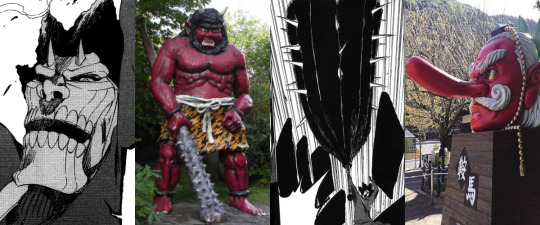
Love’s sword is a simple yet weird one. The name Tengumaru(天狗丸) is just Tengu(天狗) and the suffix -maru(丸) which really just serves the function of making it a name. I would imagine the Tengu is a pretty well recognized bit of Japanese mythology, even outside of Japan by now. There’s a neat history to them and how they got their name, and the way they look in art, and their shifting role in folk lore and mythology from antagonistic bringers of war to benevolent, if still dangerous, protectors of the mountains and nature, as well as their association with the Japanese religion of Shugendo in particular... But none of that seems to be referenced here. In fact there doesn’t appear to be any actual reference to the Tengu at work at all....
Love’s mask is a pretty stock and standard Oni or devil mask, and the giant iron bludgeon weapon is a stylized kanabou(金棒) which is also associated with oni imagery, but not Tengu. If anything, the general shape and size of his giant club might be a play on the shape of a humanoid Tengu’s iconic long nose, while the long nosed Tengu’s red face might be the influence for the fire powers, but the Tengu itself doesn’t have any particularly strong direct associations with fire... and moreover neither the tengu nor the oni seem to have anything to do with Love’s whole “love” theme in his name.
His release call is uchikudake(打ち砕け) which is just a pretty straight forward action for an iron club, “Crush.” He uses a technique called Hifuki no Kozuchi(火吹の小槌): “Little-Mallet/Gavel of Fire-Breathing” but I feel like the “Little Mallet” bit is a reference to the Uchide-no-Kozuchi(打ち出の小槌). In the Issun-boshi myth, where the little hero retrieves it from an oni he defeats; the magic hammer allows him to grow to regular human size. Similarly in the myth of Momotaro, the hero obtains the mallet from the oni-island. I only get this impression because if it’s not a reference, then it feels really weird to call a massive club “little-hammer“ as if that were a literal description.
On second thought, I forgot that tengu nose is pretty commonly used as phallic image, so it’s entirely possible that that’s the link to the “Love” theme.

Lisa’s is a real weird one though... Her shikai is called Hagurotonbo(鉄漿蜻蛉), which is the name of the Calopteryx atrata damselfly. And I guess the generally bodyshape of a dragonfly could be seen as reflected in the shikai being a polearm, but that feels kind of weak... The specific kanji used here for Haguro(鉄漿) means “Iron Drink” and refers to Haguro(歯黒) “Tooth-Blackening” which was a kind of fashion trend in Japan prior the the Meiji restoration, primarily among married women of some courtly status, although it did eventually spread into general public style as well. The "Tooth”+”Black” writing is fairly obvious, but the “Iron”+”Drink” form refers to the fact that the tooth dying concoction included dissolved iron powder.
So in Lisa’s case it’s kind of weird... Is it just a reference to the species of black-winged damselfly? Is it some kind of evocation of the old fashion of a married noble woman? Her shikai is a strange blade shape that could be either an exaggeratedly broad yari spear, or some variation the Chinese Monk’s spade. And her mask is a diamond with a cross slit that doesn’t appear to be related to the shikai form or name at all...(if anything it just kind of randomly looks like the head piece of the Zeon mobile suit, Gyan) her release call is tsubuse(潰せ):”to crush/flatten,” which also doesn’t seem related to anything other than paddling something with the broad end of her spear.
In fact if there’s anything that actually seems to suggest a real theme it’s the random technique she has named Nijuuichijou Tonbokudari (二十一条蜻蛉下り): “21 Clauses Dargonfly Descent,” which she technically used fighting Gerard Valkyrie, but we barely really saw. It looks like a super specific direct reference to Taika Nijuuikkajou Youkyuu(対華21ヶ条要求): generally known in English as “The 21 Demands” referring to the terms of surrender Japan made of China in their conquest of Manchuria during World War 1. The demands were ultimately negotiated down to more favorable terms for China, minimizing Japanese expansionist gains, but the signing resulted in massive distrust between Japan and America, Japan and Britain, and of course Japan and China.
But all together these elements don’t seem to have any kind of cohesive theme behind them all...

Anyway, that’s the Visored swords, it’s really weird to think that Kubo basically had to come up with all of these names and designs at basically the same time yet the level of thought and investment in them seems to be all over the place.
45 notes
·
View notes
Photo

Cow Parsley, not to be confused with Elderflower.
28.03.2020 My ninth posting
Flowers, hedgerows, shrubs, trees, log piles and a pond all feature in our garden. Our philosophy is ‘benign neglect’ but what we lose in attractive, manicured perfection, we gain in natural surroundings and all the life that approach attracts.
My camera’s not high end by any means but it’s a big step up from the pocket point and shoot I started off with. Never the less, this is one of my favourite garden photos with that first camera. It’s a female Broad Bodied Chaser Dragonfly on a Weigela shrub.
The pond attracts Dragonflies, Damselflies, all kinds of insects, frogs, toads and one year a trio of ducks, who we named Max, Paddy and Holy Mary in homage to Phoenix Nights. I’ll have to dig out those old photos - but today I’m mainly reminiscing about insects and bees.


Equally beautiful is this Male Demoiselle Damselfly photographed at the National Trust’s Bateman’s the historic home of Rudyard Kipling which is not too far from us. On that page you can see the bridge I was stood on to get this picture. It’s not the sharpest as it was a very long zoom in but it was a good spot and as it was in constant movement and very quick, I felt lucky to get any photographs at all.
We get new bugs inside the house all the time too. Here is an Ermine Moth on a duvet - very unusual and interesting to look at, the moth that is, not the bedding. The link says they’re common but I’ve never seen one before or since.

We get hitch hikers in the garden and intruders in the bathroom

not to mention those scary things that come in with the logs for the fire - Devil’s Coach Horse beetle, ever heard of those? WARNING Link here contains a big picture. They look and behave like miniature Scorpions.

Known in our house as ‘Wilf’ I’m reliably told the hitchhiker’s a Great Green Bush Cricket Tettigonia viridissima further link.

We’ve also had some aggressive Hornets in recent years. The jury’s out I guess about how much of a problem they are. I tend to want them gone as I worry about the Bee population being attacked by them. This one was found dead in the fireplace. It was huge.
In the garden, I’ve tried to choose a selection of shrubs and flowers that are attractive and hospitable to our wildlife and think so far it’s gone pretty well despite my efforts to have a thriving wild flower patch falling well by the wayside. Where my efforts fail though, nature is sometimes quick to populate what we laughing call ‘the lawn’ This was definitely the Year of the Buttercup.




Of course it’s not only winged beings we see over our gardens, sometimes we have to share the beautiful views with visitors of quite another kind.

Ballooning over the countryside on a fine day looks absolutely amazing.

And we were very lucky to see numerous planes fly in the D Day 75 Memorial Flight over Kent and Sussex, 5th June 2019.



It just goes to show that if you keep your eyes and ears open, even from your own windows, you never know what you might see.
And just a note to finish off today, because most of us are forgetting which day it is - Clocks Go Forward tonight UK.

2 notes
·
View notes
Text

The Giant Petaltail is native to Queensland, Australia. The petaltails get their name from their club-ended tails. The species name 'ingentissima' comes from the Latin adjective 'huge', and the Giant Petaltail is the largest species of Dragonfly in the world, with a body length of 12cm and a wingspan of up to 16cm.

The Swamp Bluet Damselfly is native to streams and rivers in Victoria and Tasmania, Australia.

Although Dragonflies and Damselflies are part of the same order, there are a few differences between them. While the eyes of a dragonfly wrap around their head, damselfly eyes jut out and are separate. Dragonfly wings are broad from the base and the hindwings are larger, while damselfly wings are narrow at the base and of equal size. Damselflies fold their wings to their body when resting, but dragonflies cannot do this. Dragonfly bodies are usually shorter and bulkier than damselflies. Dragonflies are stronger fliers than damselflies, but both are successful in captured other flying insects mid flight.
1 note
·
View note
Text



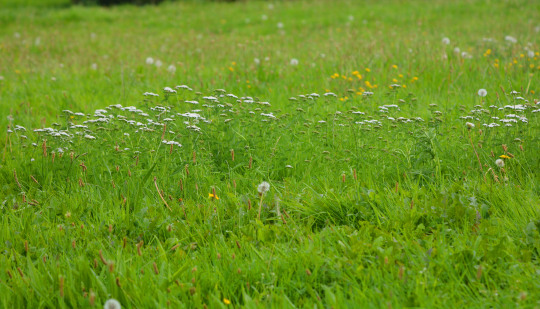



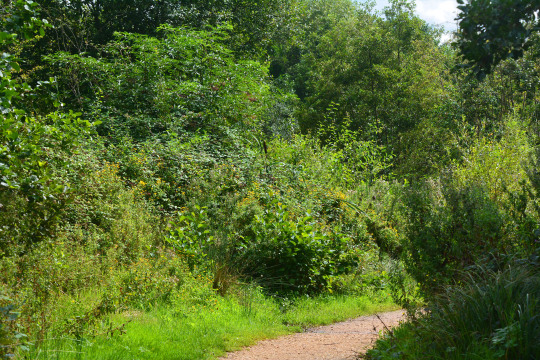
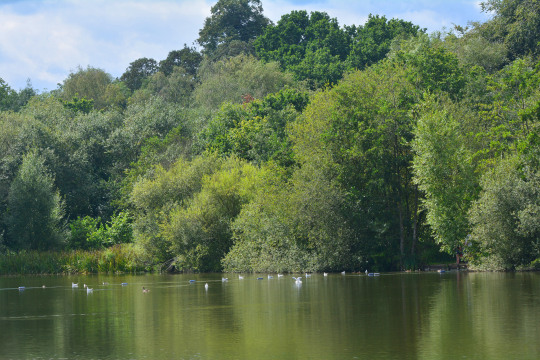
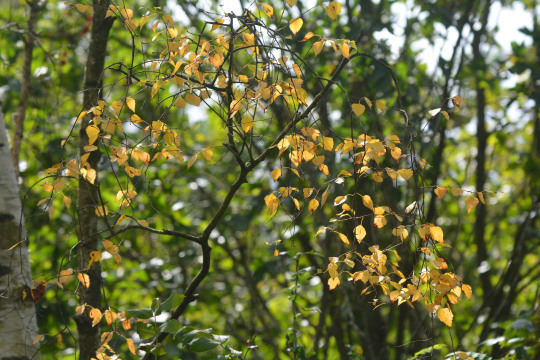
25/08/23-Lakeside and home
Photos taken in this set: 1. An eyecatching Blue-tailed Damselfly which I enjoyed seeing at Lakeside, it's been great to see these increase in number recently, a lovely damselfly species. 2. A nice Light Brown Apple moth in the kitchen last night. 3. Woodpigeon in the sun this evening. 4. Some yarrow and dandelions on the green out the front, the tall clumps of yarrow a nice prominent sight on the green out the front from home of late. 5. Carrot by the flower bed area on the way to Lakeside. 6, 8 and 9. Vibrant views on the lovely Lakeside lunch time walk. 7. One of two charming Common Darters I enjoyed seeing landing in the southern fenced off area, I saw a fair few of both sexes on the walk as a whole. This one settled and I enjoyed a glorious few minutes watching and photographing it. It was lovely to just focus on looking at it and take in many details, the way it landed with its pellucid wings covering its eyes reminded me of a wedding veil and the eyes themselves were a source of my fascination, complex patterns and shaped like half a planet I felt privileged to see them move around to take in surroundings. This was a big moment feeling the joy of having a connection with nature, for a short time getting to share this insect's world. And on my first time out since Tuesday as I just felt well enough to do a walk in the midst of my bug this was a moment I needed with a classic summer species I'm loving seeing the past few weeks. 10. Some yellow leaves at Lakeside.
Another big point with insects in the southern fenced off area was seeing my first Small Heath here since spring, with Red Admiral, many marvelous views of Meadow Brown, Speckled Wood and Migrant Hawker over the lake seen well. Great Crested Grebe, Carrion Crow and Magpie with Moorhen and Chiffchaff heard were other avian highlights of an enjoyable walk. Collared Dove, Starlings and Goldfinch including young were good to enjoy at home today. It was also nice to see a Small Dusty Wave moth again before bed last night. Bird's-foot trefoil, fresh vetch, dock, red bartsia, St. John's-wort, white and broad-leaved clover, great willowherb, purple loosestrife, immaculate looking bramble flower and some gorgeous lady's bedstraw which is fresh in the southern fenced off area were other key flowers seen on my lunch time walk. Ripe ruby guelder rose berries, hawthorn and rose hips and blackberries were nice to see.
#photography#common darter#great willowherb#lady's bedstraw#red admiral#blackberries#chiffchaff#great crested grebe#darter#blue-tailed damselfly#magpie#carrion crow#birdwatching#insects#insect#friday#walk#walking#lakeside country park#lakeside#outdoors#connection#nature#eyes#wings#red#europe#colours#flowers#green
3 notes
·
View notes
Photo


American Rubyspot
Hetaerina americana
Concan, Texas, United States, 2015
Garner State Park
#american rubyspot#hetaerina americana#rubyspot#hetaerina#broad-winged damselfly#calopterygidae#demoiselle#jewelwing#damselfly#zygoptera#odonata#insect#insecta#arthropod#arthropoda#invertebrate#Concan#Texas#United States#garner state park
7 notes
·
View notes
Text
A Reflection With Nature
Sunlight shimmers
through the treetops,
to dance across the grass.
Stone steps
are worn. Weathered
by years in the elements.
Hop trees are growing,
their broad leaves
grouped in threes.
A fallen magnolia seed
lies upon the earth,
its chance to bloom, gone.
Bark, of a silky dog wood tree,
is smooth
beneath my hand.
Leaves of the surrounding trees,
now yellow, orange, red
fall as Autumn approaches.
Monarch butterflies,
flutter low
beneath a magnolia tree.
Hidden within,
behind thick leaves, closed flower buds
Mockingbirds build a nest,
A damselfly chases a wasp,
around and around
a low brick wall, surrounded by grass
Leaves of the two wing silver bells,
cover your head
like that of an umbrella.
Cicadas sing into the day,
while crickets too play their tune,
reminiscent of a warm summer night.
#poet#poetry#poem#writer#escaping through word#nature poem#sun#flowers#butterflies#garden#reflecting#nature#cicadas#mockingbirds#autumn#red#orange#yellow#sunlight#trees#creative writing
2 notes
·
View notes
Photo










Ebony Jewelwing - Calopteryx maculata
As promised from Tuesday, it is time to showcase some iridescent female Ebony Jewelwing individuals. Just like the male individuals shown on Tuesday, these insects are absolutely gorgeous! Enjoy the sight of these beauties while they remain active during the summer. How easily can you tell the males and females apart from a picture? Simple really: look to the wings. Compared to the wings of the males with are uniformly dark with no embellishment, the females’ wings aren’t as dark; they are described as smoky in appearance. There is variability to this of course, in which case it’s better to look a little bit closer at the wings to see a white spot (on the pterostigma). It may look like the spot only appears on the forewings, but looking at Picture 5 you can see that each of the 4 wings house a spot which appear to perfectly overlap while at rest. Normally other Odonate insects have pterostigma that is colored while the wing itself is clear, so it’s interesting to see such an inversion in nature.
Though I’ve gone on about the iridescence, looking at the individuals a bit closer seems to showcase that the female Ebony Jewelwings appear to be duller in appearance compared to the males. Could there be a reason for this (similar to birds and their plumage)? Maybe, and it may have something to do with how these female and male Damselflies find each other in the wild. Similar to some species of Butterflies, the male Jewelwings claim and hold territory by the water’s edge. They then remain vigilant, waiting for a female to come along so they can impress her with a dance-like display. While territory is important, given the methods of selection, it might be possible that the male’s color is important as an indicator of health, and as such female color may be less important. Just an idea. In any case, after females and males have chosen each other, the females will lay their eggs in the nearby stream or body of water when the water moves slowly. Alternatively, the female can also house their eggs in water plants as well. While this occurs, the male will guard her in protect his future children, shooing away other males. Shooing is what’s suggested, by the reality indicates the male Damselfly may need to use their mandibles and spiked legs against their competitors.
Pictures were taken on June 16, 2021 with a Google Pixel 4.
#jonny’s insect catalogue#insect#damselfly#ebony jewelwing#broad winged damselfly#odonata#toronto#june2021#2021#ontario insect#entomology#nature#invertebrates#arthropods
0 notes
Photo

D + E⠀ GERMAN Junges Männchen der Blauflügel-Prachtlibelle(Calopteryx virgo) im verwilderten Nachbarsgarten. Die Nähe des Baches macht sich bemerkbar. Denn Fließgewässernähe von kleinen/mittleren Bächen ist das Habitat dieser eher seltenen Art. Sie werden 45-49 mm lang und haben eine Spannweite der Flügel von 65-74 mm. Eine große Besonderheit im Vergleich zu allen anderen Libellen ist der Schwirrflug des Blauflügel-Prachtlibellen-Männchens. Die Flügel des Männchens bewegen sich dabei so schnell, das man fast nur einen breiten blauen Streifen sieht. Das ist wirklich unglaublich schön. Prachtlibellenmännchen schaffen es bei ihren Balzflügen auf max. 50 Schläge pro Sekunde. Für eine noch höhere Schlagfrequenz reicht die Muskulatur der Tiere nicht aus. Quelle: www.waldschrat-online.de⠀ ⠀ ENGLISH Young male of the blue-winged damselfly (Calopteryx virgo) in the overgrown neighbouring garden. The proximity of the stream is noticeable. Because flowing water near small/medium streams is the habitat of this rather rare species. They are 45-49 mm long and have a wing span of 65-74 mm. A great special feature compared to all other dragonflies is the buzzing flight of the blue-winged splendid male dragonfly. The wings of the male move so fast that you can almost only see a broad blue stripe. That is really incredibly beautiful. Male dragonflies can reach a maximum of 50 beats per second in their courtship flights. The musculature of the animals is not sufficient for an even higher stroke frequency. Source: www.waldschrat-online.de⠀ ⠀ #raw_community_member #batpixs_nature #loves_united_nature #ptk_nature #srs_nature #bokeh_shotz #bokeh_addicts #bokehcity #picture_to_keep #amazing_shots #loves_garden #bokeh_kings #BOKEHKILLERZ #pearlsofbokeh #bns_nature #kings_shots #raw_allnature #be_one_natura #fever_natura #shots_r_stars #natürlichimahrtal #insectguru #raw_insects #insectmagazine #insectraw #KINGS_INSECTS #total_insects #IP_INSECTS #wholelottabugs #insects_of_our_world — view on Instagram https://ift.tt/381MvIZ
0 notes
Photo

Repost @plantsandbugs Libellula luctuosa - Widow Skimmer . . DRAGONFLY FUN FACTS: . 1 ) Dragonflies were some of the first winged insects to evolve, some 300 million years ago. Modern dragonflies have wingspans of only two to five inches, but fossil dragonflies have been found with wingspans of up to two feet. 2 ) Some scientists theorize that high oxygen levels during the Paleozoic era allowed dragonflies to grow to monster size. 3 ) There are more than 5,000 known species of dragonflies, all of which (along with damselflies) belong to the order Odonata, which means “toothed one” in Greek and refers to the dragonfly’s serrated teeth. 4 ) In their larval stage, which can last up to two years, dragonflies are aquatic and eat just about anything—tadpoles, mosquitoes, fish, other insect larvae and even each other. . . Widow Skimmer is one of the group of dragonflies known as king skimmers. The nymphs live in the water, molting and growing until they are ready to emerge from the water and then molting a final time to reveal their wings. Widow skimmers have large bulky bodies, with large head. Adults have a steely blue body area but juveniles are yellow with brown stipes. Eyes are also large and close together meeting in the middle of the head. They have three pairs of legs. Legs are black in color. They have two pairs of wings: forewings and hindwings. Wings of both sexes are marked with prominent black basal bands. They keep their wings extended over their bodies. Adult males develop broad white spots at midwing as they mature. The abdomen measures 24–32 mm. They also have a slight white hue on their abdomen and thorax. . . . . . . #dragonfly #odonata https://www.instagram.com/p/BzCy4-XFDRr/?igshid=en31xxlyp3pj
0 notes
Text
A beginner's guide to butterfly watching
New Post has been published on https://nexcraft.co/a-beginners-guide-to-butterfly-watching/
A beginner's guide to butterfly watching
Old World swallowtails like this one hang out on the West Coast or in Alaska. (Deposit Photos/)
Cliff Hagen spotted it from about 15 yards away: a powder blue spring azure butterfly, bouncing out of sight behind a tree.
“That’s our first one of the day,” Hagen said to a half-dozen volunteers gathered around him for the annual Staten Island butterfly count he led at the end of June.
By the end of the outing, the group tallied 346 individual butterflies representing 24 species across several sites. Hail and thunder ended their 8-hour effort.
Among their finds: stained-glass American ladies perched on lavender, broad-winged skippers and buckeyes swirling in a whirl of rust and orange, and a dusty-looking common sootywing resting on a dandelion. The group counted least skippers, one of North America’s smallest butterflies (no bigger than a pinky nail), on the outskirts of the wetlands at Snug Harbor Cultural Center and Botanical Garden. And lots of cabbage whites, fluttering all over the place.
During the weeks around the Fourth of July, groups like this one survey natural areas across the country and world to take stock of butterfly populations. For many beginner butterfliers, the counts are an easy way into the outdoor pastime.
Butterflying may not be as popular as birding—the 5,000-strong North American Butterfly Association is miniscule compared to the country’s 45 million birders. But that’s because butterfly-chasing remains “massively underrated,” according to Rosemary Mosco, a science writer and butterflier who recently took to Twitter to share what she loves about her hobby.
“A lot of people think that butterflies are frilly and boring,” she says. “But they are just so cool and bizarre and fascinating. It never gets boring.”
Some are carnivorous, others are adorable, and a few have long snouts. You can find them everywhere from bogs to mountainsides. About 20,000 butterfly species populate the globe; about 600 reside in the Lower 48. Most people in the United States live near about 100 butterfly species—more in the Rio Grande Valley and less in New England, NABA says.
So if you’re looking to break into butterflying, we’ve got the basics right here.
What you’ll need
A field guide like <a href=”https://press.princeton.edu/titles/10985.html”>A Swift Guide to Butterflies of North America</a> or the <a href=”http://www.kaufmanfieldguides.com/butterflies.html”>Kaufman Field Guide to Butterflies of North America</a>
Binoculars (optional)
Camera or smartphone for photos (optional)
Luckily, that’s not much.
A field guide is your most important tool. When you set your sights on a flutter-by, the book will help you first sort your subject into one of the six butterfly families in North America: swallowtails, whites and yellows, gossamerwings, metalmarks, brushfoots, and skippers. They also contain useful information about each species’ biology: their size, habitat, food and migration season.
You might consider investing in a pair of binoculars so you can really zoom in on the detail and color of a butterfly, some of which can be dime-sized or smaller. Unlike birders, who point their binoculars up, butterfliers point theirs down. Most binoculars will go blurry if you get closer than 10 feet from your subject, so Jeffrey Glassberg, NABA president and author of the Swift field guide, recommends finding a pair that will give you a sharp view within several feet of a butterfly.
And while you may be envisioning an idyllic image of chasing butterflies with a net, Glassberg warns against the “unnatural and vulgar experience” of netting one for a closer look or to keep as a collectible. “There’s no need to carry a net,” he says.
Where you should go
Unsurprisingly, almost anywhere.
Your best bet for finding butterflies is the open space of any nearby natural area around midday. Butterflies (like amphibians and most reptiles) are ectotherms, which means their internal temperature is regulated by their environment. The sun-soaking creatures will literally hide from cold, dampness, or a tousling wind. Some, like the question mark butterfly, are known for emerging later in the day.
As a butterflier, you’ll quickly learn that certain butterflies prefer certain habitats—wetlands, meadows, shrubs, or woodlands, for example—or can only be found near their host plants. As you may remember from your school days, monarchs mill around milkweed plants. Some swallowtails stick to herbs like parsley or tarragon, while coppers count blueberries and buckwheat among their preferred habitats. Other species feed on decaying plant matter or feces.
How to get started
See all those butterflies out there? No? That’s because you haven’t started looking yet! (Deposit Photos/)
Step one: sleep in.
Unlike birders, some of whom drag themselves out of bed before dawn for their hobby, butterfly-watchers need to wait until the day is warm enough for their subjects to emerge.
And unlike birds, butterflies are relatively easy to get close to.
“Birds don’t want to be approached,” says naturalist Jim McCormac, who maintains a blog on the many creatures inhabiting his home state of Ohio. “Approach is way easier with butterflies.”
When you see one you’d like to examine, it’s time to get sneaky. Mosco recommends creeping up on them while staying low to the ground, without breaking the horizon line. Once you’re close enough, snap a picture. That way, you can compare your photo to a field guide at your leisure, she says.
Don’t try to do too much, too fast. Practice identifying families first before you worry about pinning down any species.
Hagen suggests focusing on their movement—how high or low they fly from the ground, and whether they bob, dance, or perch.
“It’s not just what they look like, it’s how they’re acting” Hagen says.
And if that still feels daunting, there are about two dozen NABA chapters and other local butterfly clubs that host meetings and field trips with people who will be happy to guide you through your first butterfly expeditions. “More eyes, more butterflies,” is Hagen’s motto.
“Learning from other people is the easiest way,” Glassberg says. “It’s very easy to get involved.”
Why you should do it
“They’re beautiful—that’s the main draw,” McCormac says. “They’re works of art.”
And if the splendor of our teensy winged friends isn’t enough to draw you in, consider that spending time outdoors is a proven health benefit for better sleep and improved mental health. Just two hours outside each week is enough for a noticeable health impact. “Butterflying is good for human beings,” Glassberg says.
The hobby also demands a mental awareness that can be both meditative and surprising. On a butterflying outing, it’s hard not to notice all the other creatures—indigo buntings and woodpeckers, beetles, moths, damselflies, and dragonflies—flitting around the technicolor blooms and greens of summer.
Ultimately, Glassberg hopes, participation in butterflying encourages people to want to conserve butterflies and their habitats.
“If something’s not part of your life, you’re not going to care if it’s gone,” he says.
Written By Marion Renault
0 notes